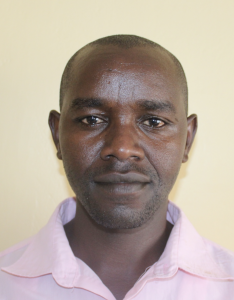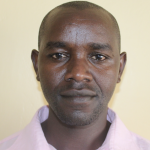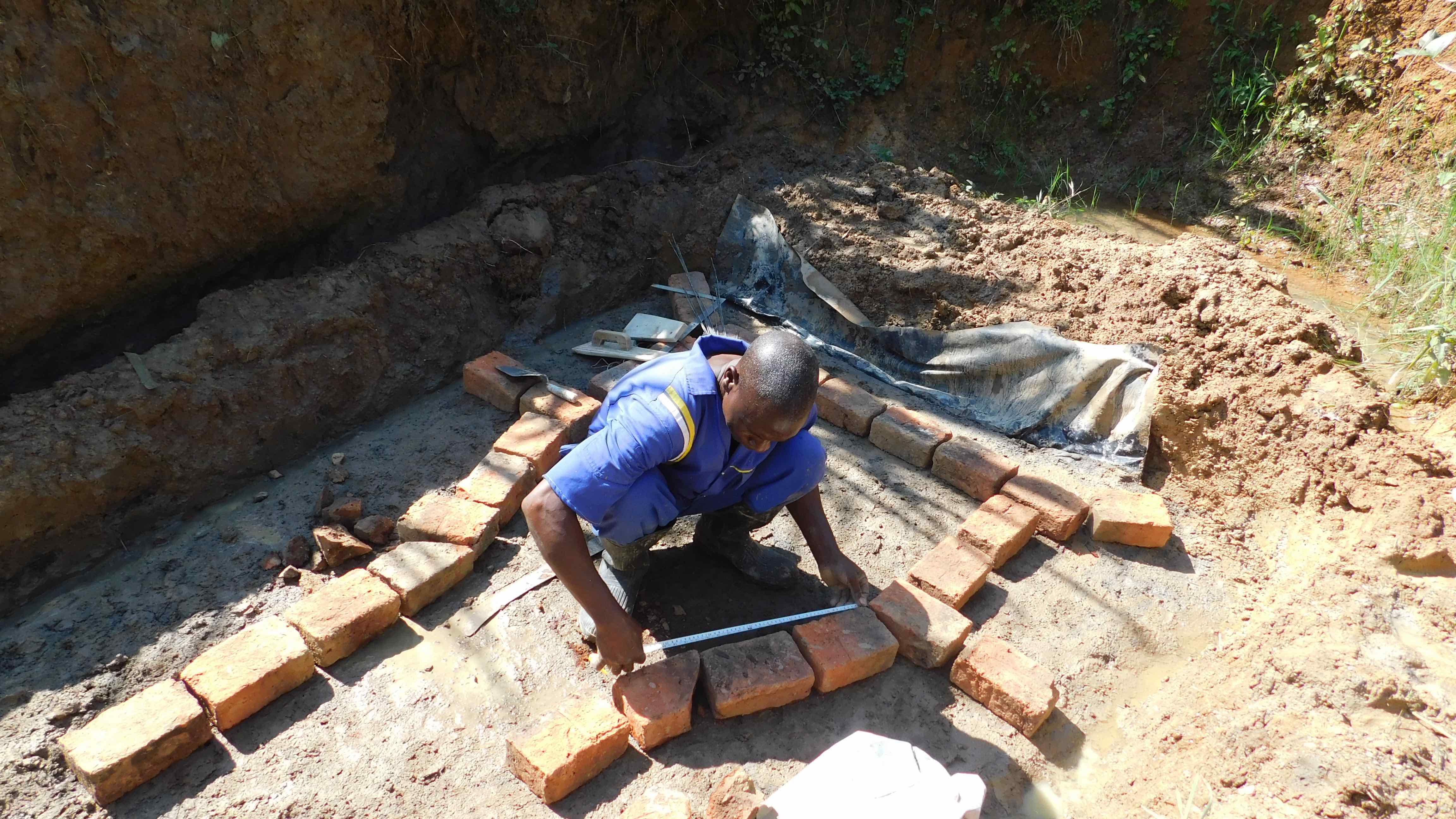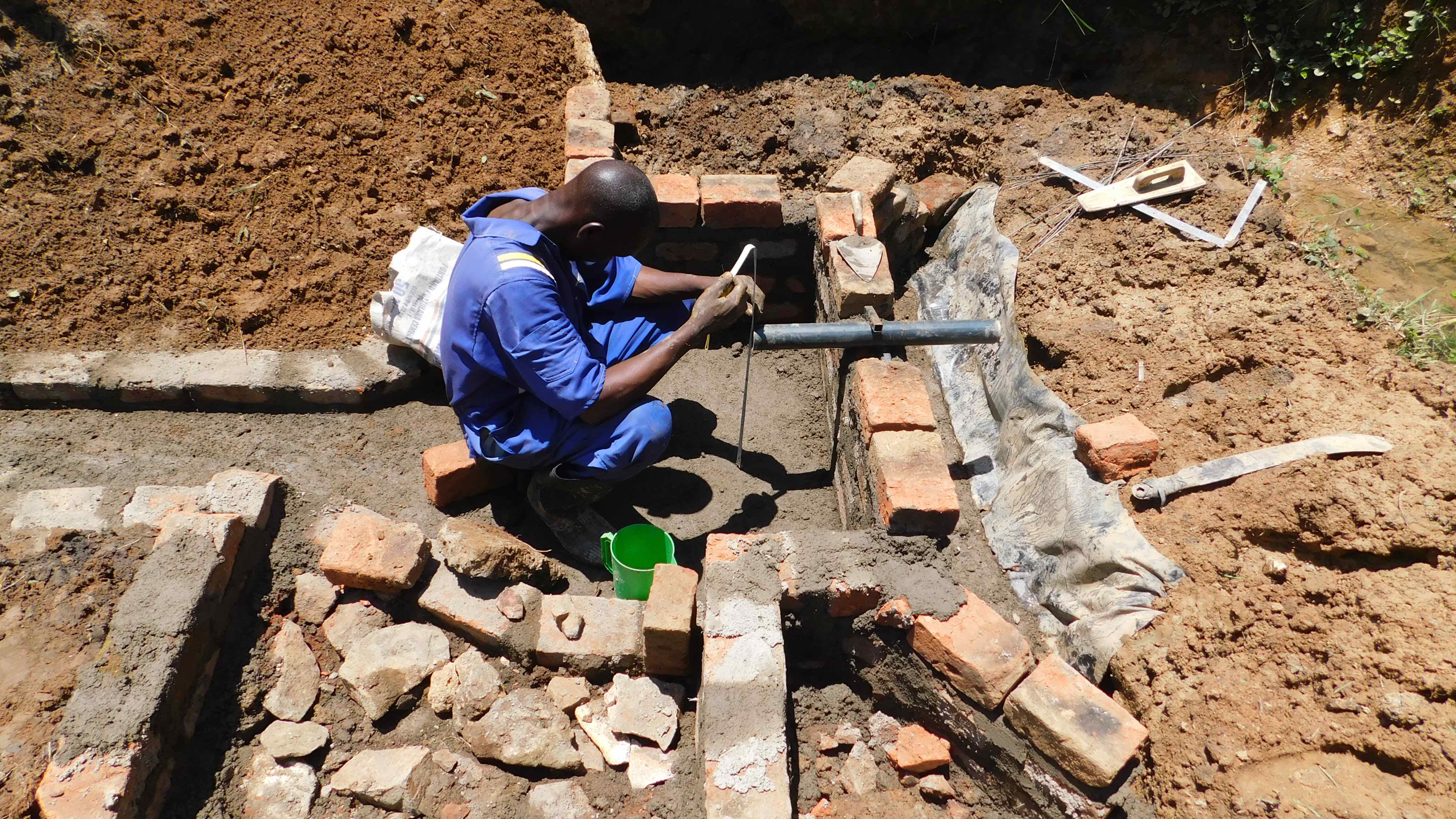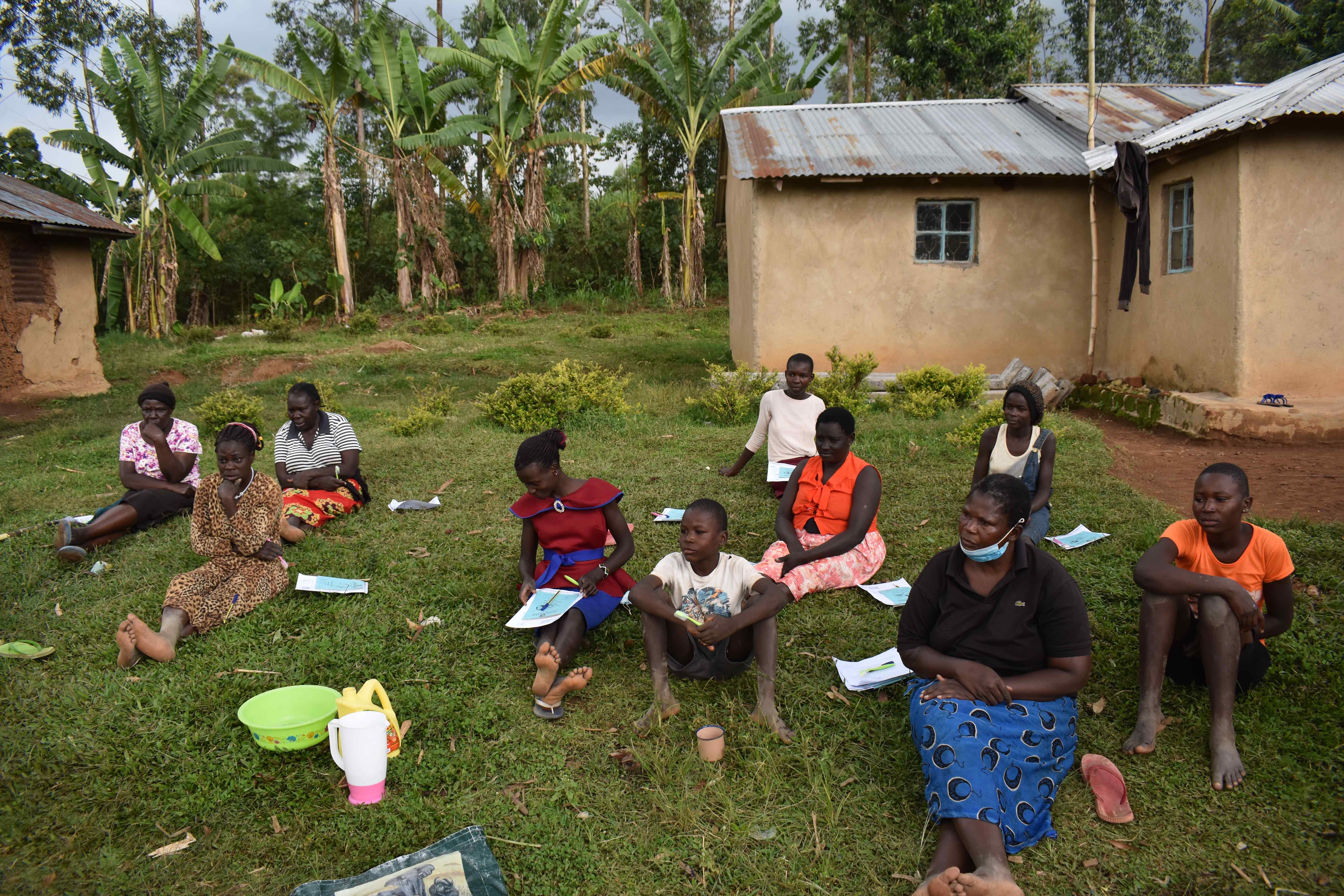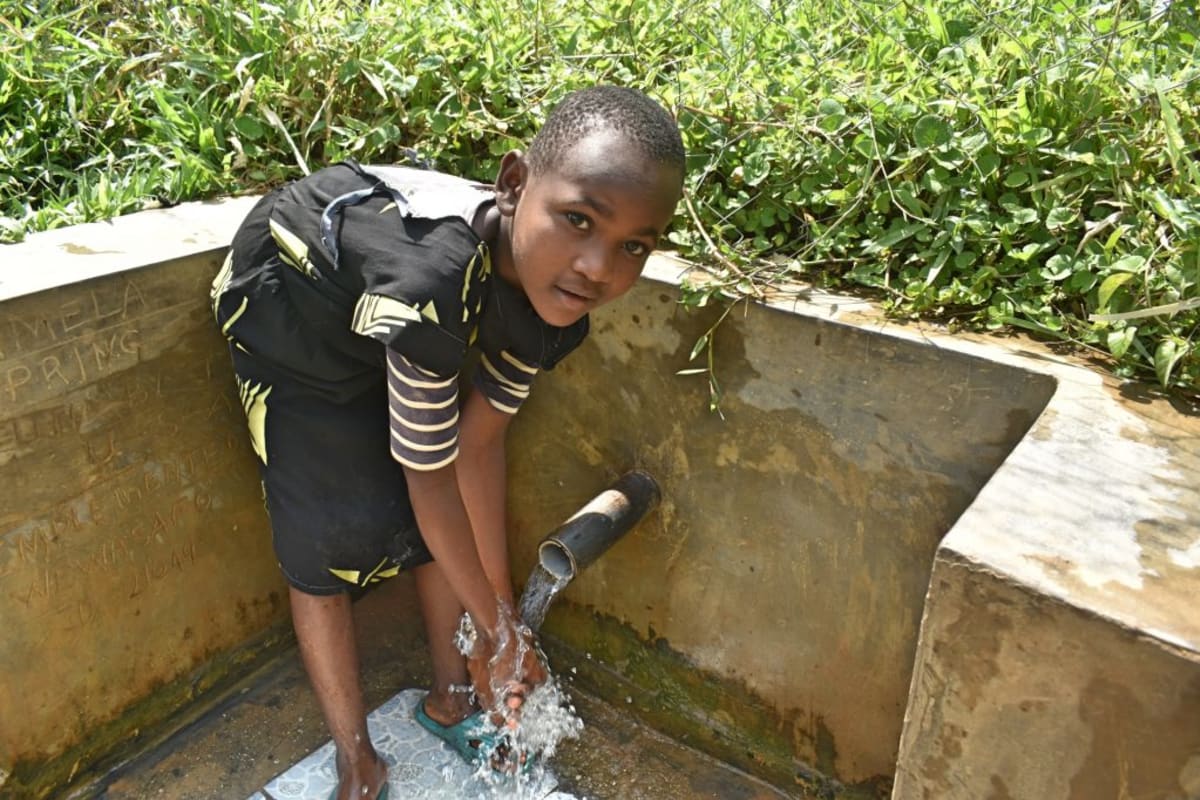The Mundoli community is home to fertile land and good drainage, lending its community members to a strong tradition of agriculture. Farming activities include growing sugarcane, maize, vegetables, cassavas, and sweet potatoes, and rearing cattle, pigs, sheep, and goats. In every household, there is at least one chicken as these are associated with the Luhya culture here. People also keep ducks as a predator to wandering snakes, which tend to invade homes during the hot seasons.
Fetching water first thing every morning before doing any other chore is the norm in Mundoli. This is because, for the 151 people here who depend on Pamela Atieno Spring for water, the spring gets more crowded and the water dirtier the later in the day you arrive.
Pamela Atieno Spring looks like a long open puddle in the earth. Contamination is rampant in the open spring water. Its bottom is covered in sand, mud, rotting leaves, and algae. Inside the water, insects and small animals such as frogs, snakes, and more call it home. Runoff from the rains flows straight into the spring water, mixing farm chemicals, residues from animal waste, and soil into the water people drink. People step in the water, wash their containers with soap inside the spring, some people bathe there, and animals walk through it, defecate in it, and drink from the same source. This water is not safe for human consumption.
"I feel very bad every time I think of our water source, which poses a danger to our health and our children. Being a low-class income earner, I sometimes miss going and doing casual jobs due to body weakness caused by drinking the contaminated water. A wasted day for me means that my family will stay without food because I am the sole breadwinner," said 46-year-old Florence Ng'anyo, who doubles up as a village leader and also the interim chairperson for the unprotected spring.
Community members report waterborne and water-related cases of diarrhea and coughing are widespread among families who depend on this spring. With heightened tensions around COVID-19, however, many people say they are scared of going to the hospital for medical attention for fear of being mistaken as COVID-19 patients.
If they do seek medical attention, these illnesses can be expensive to treat, draining families of their financial resources. If they do not, they risk their life, especially when it is their children who get diarrhea. When sick, adults lose a lot of productive time while recovering, and children miss their classes, often falling behind their classmates at school.
"Sometimes I stay home not going to school when I am not feeling well after drinking bad water, which makes me sick and tired for some days. It is only during this Corona period that I have stayed home for a long time, not because of drinking dirty water but because of the pandemic. Previously, when all was well, my academic performance would fluctuate, sometimes up and at times below [average]," explained young primary school student Faith.
Accessibility and time wastage are additional challenges at the spring. To draw water, community members must first perch on a few stones they placed across the spring to provide a makeshift dry spot. But the stones are covered in algae and usually wet, causing people to slip. Sometimes just their toes or shoes dip into the water, but falls are not uncommon.
Then, going one or two people at a time, they carefully submerge their container into the pool of water as deep as they can to let it fill. Next, they have to top off their jerrycan using a smaller jug, bowl, or cup to scoop water from the spring and pour it into their larger jerrycan. Between fetching, people must wait for the water to settle lest they get extra sand and algae in their jerrycan.
This is why the morning is best for fetching, but everyone has the same idea, leading to lines. With all this time spent trying to get the cleanest water possible, women face delayed daily work schedules and children are often late to school.
Two dedicated and committed women, both widows and neighbors, lead this spring's management. They are Pamela Atieno, the spring's landowner, and Florence Ng'anyo, quoted above. According to Pamela and Florence, their family status is what motivates them to work tirelessly to ensure that they achieve what lies ahead of them in the spring protection without being deterred by the dissenting voices from other community members who, in one way or another, may not be able to see the women's or the spring's potential.
To put their desire straight, Pamela and Florence singled out this spring as their main achievement and gift to the community at large. They look forward to seeing that their water source is protected, they said, to be able to bring safe, clean drinking water to their community.
What We Can Do:
Spring Protection
Protecting the spring will help provide access to cleaner and safer water and reduce the time people have to spend to fetch it. Construction will keep surface runoff and other contaminants out of the water. With the community’s high involvement in the process, there should be a good sense of responsibility and ownership for the new clean water source.
Fetching water is a task predominantly carried out by women and young girls. Protecting the spring and offering training and support will, therefore, help empower the female members of the community by freeing up more of their time and energy to engage and invest in income-generating activities and their education.
Training on Health, Hygiene, COVID-19, and More
To hold trainings during the pandemic, we work closely with both community leaders and the local government to approve small groups to attend training. We ask community leaders to invite a select yet representative group of people to attend training who will then act as ambassadors to the rest of the community to share what they learn. We also communicate our expectations of physical distancing and wearing masks for all who choose to attend.
The training will focus on improved hygiene, health, and sanitation habits in this community. We will also have a dedicated session on COVID-19 symptoms, transmission routes, and prevention best practices.
With the community’s input, we will identify key leverage points where they can alter their practices at the personal, household, and community levels to affect change. This training will help to ensure participants have the knowledge they need about healthy practices and their importance to make the most of their water point as soon as water is flowing.
Our team of facilitators will use a variety of methods to train community members. Some of these methods include participatory hygiene and sanitation transformation, asset-based community development, group discussions, handouts, and demonstrations at the spring.
One of the most important issues we plan to cover is the handling, storage, and treatment of water. Having a clean water source will be extremely helpful, but it is useless if water gets contaminated by the time it is consumed. We and the community strongly believe that all of these components will work together to improve living standards here, which will help to unlock the potential for these community members to live better, healthier lives.
We will then conduct a small series of follow-up trainings before transitioning to our regularly scheduled support visits throughout the year.
Training will result in the formation of a water user committee, elected by their peers, that will oversee the operations and maintenance of the spring. The committee will enforce proper behavior around the spring and delegate tasks that will help preserve the site, such as building a fence and digging proper drainage channels. The fence will keep out destructive animals and unwanted waste, and the drainage will keep the area’s mosquito population at a minimum.

 Protected Spring
Protected Spring
 Rehabilitation Project
Rehabilitation Project








